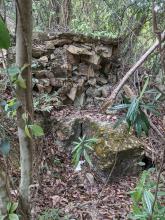Former Stanley internees John Power and his wife Mary are arrested at their house in Kowloon's Granville Road..
The arrests of spring 1943 and the subsequent imprisonments and executions hampered but did not destroy the resistance in town. Between May and July 1943 most of the uninterned British nationals who weren't arrested - mainly bankers and health workers - were sent into Stanley, but the British Army Aid Group continued to have a network of Chinese agents, and Chinese people, appalled at the brutality of the occupation, continued to come forward. They were supplemented by recruits from other nationalities, and the records show French and Indians, as well as Hong Kong Eurasians, joining in late 1943 or 1944.
John Power was Irish, and Irish neutrality was the reason he and Mary were released from Stanley after initial detention there. At some point he began to carry out underground activity, including listening to English-language radio broadcasts and passing on the news. One of his associates was arrested on June 16 and eventually gave his name under torture.
When the Kempeitai came to his house, they arrested him even though his radio was officially licensed - 'castrated' so it couldn't pick up British or American broadcasts - it's possible he got the news by tuning into nationalist programs from Chungking, or he might have had, as others did, a hidden attachment that restored the radio's full tuning capacity. In any case, he was 'guilty' of passing on the news - the Japanese had not been concerned about knowledge of the war in Europe until D Day (June 6, 1944) after which they treated anyone caught passing on information with the utmost severity. Mr Power was almost certainly engaged in other underground activities too.
Both John and Mary Power suffered brutal interrogations. She was released on September 6, 1944, he died in prison as a result of this mistreatment.
Source:
China Mail, April 17, 1947, page 2
Note
Another account suggests that Mrs Power might have been taken away the next day - China Mail, May 23, 1946, page 8


